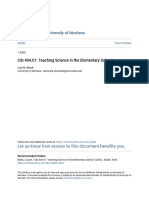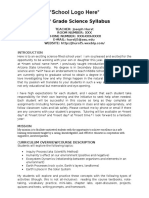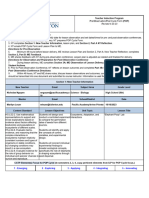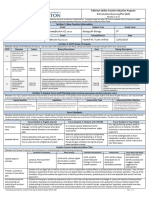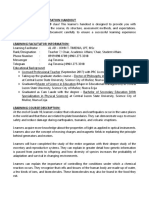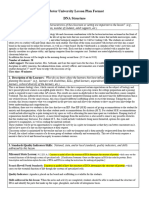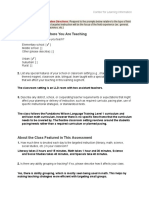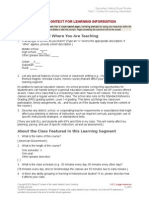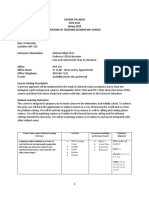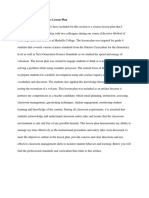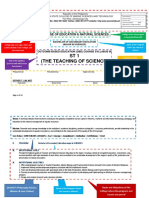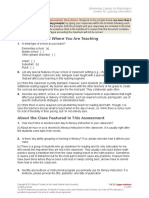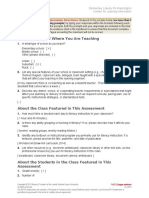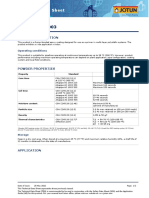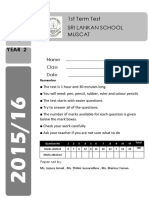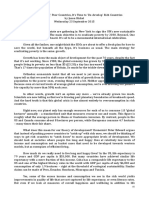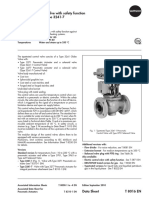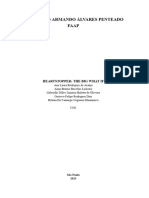Secondary Science
Task 1: Context for Learning Information
TASK 1: CONTEXT FOR LEARNING INFORMATION
Respond to the prompts below (no more than 4 single-spaced pages, including prompts) by typing your responses within the
brackets following each prompt. Do not delete or alter the prompts. Pages exceeding the maximum will not be scored.
About the School Where You Are Teaching
1. In what type of school do you teach? (Type an “X” next to the appropriate description; if
“other” applies, provide a brief description.)
Middle school: _____
High school: X
Other (please describe): _____
2. Where is the school where you are teaching located? (Type an “X” next to the appropriate
description.)1
City: _____
Suburb: _____
Town: _____
Rural: X
3. List any special features of your school or classroom setting (e.g., charter, co-teaching,
themed magnet, remedial course, honors course) that will affect your teaching in this
learning segment.
[This lesson builds upon what students already know about cells, specifically eukaryotic cells.
Spanning three days, the lesson is differentiated to challenge students using different learning
styles and leverages cooperative learning by having students work together in groups.]
4. Describe any district, school, or cooperating teacher requirements or expectations that might
affect your planning or delivery of instruction, such as required curricula, pacing plan, use of
specific instructional strategies, or standardized tests.
[This public high school is an active participant of a county education system. This county
system follows outlined state standards and follows a block schedule where classes are taught
every day, M-F, for 75 or 90 minutes for one semester. This school also has a “skinny” second
period that is taught all year long. The class I chose for my Teach Lessons is my fifth block
class.]
1 If you need guidance when making a selection, reference the NCES locale category definitions
(https://nces.ed.gov/surveys/ruraled/definitions.asp) or consult with your placement school administrator.
Copyright © 2020 Board of Trustees of the Leland Stanford Junior University. 1 of 4 | 4 pages maximum
All rights reserved. V07.1
The edTPA trademarks are owned by The Board of Trustees of the Leland Stanford Junior University. Use of the edTPA trademarks is
permitted only pursuant to the terms of a written license agreement.
� Secondary Science
Task 1: Context for Learning Information
About the Class Featured in this Learning Segment
1. What is the name of this course?
[9th grade Advanced Biology]
2. What is the length of the course? (Type an “X” next to the appropriate description; if “other”
applies, provide a brief description.)
One semester: X
One year: ______
Other (please describe):
3. What is the class schedule (e.g., 50 minutes every day, 90 minutes every other day)?
[Fifth block begins at 1:45 AM and ends at 3:00 PM. The class period runs for a total of 75
minutes.]
4. Is there any ability grouping or tracking in science? If so, please describe how it affects your
class.
[The County Board of Education does have a science pathway in place for all students.
Freshman students are placed either on the advanced or standard pathway. Advanced 9th grade
students take advanced biology while standard students take regular biology. Advanced
Sophomores then move on to take advanced chemistry while standard 10th graders will take
Physical Science. The following year, those same students on the advanced track will take
advanced physics and the standard track will enroll in environmental science. Now, as students
enter their senior/junior year they have a few more options. Advanced students can take AP
Biology, Dual Enrollment Biology, advanced Human Anatomy & Physiology, or an elective
science in addition to one of the previously listed courses. Standard students also have options.
Thay may take Human Anatomy and Physiology or an elective science course such as Forensic
Science, Medical Terminology, or body systems. This new and old system are now combined at
this school, so the class is made of two different grade levels with two very different exposures
to scientific phenomenon.]
5. Identify any textbook or instructional program you primarily use for science instruction. If a
textbook, please provide the title, publisher, and date of publication.
[Miller, K. R., & Levine, J. S. (2012). Miller & Levine Biology: 2014 Student Edition. Prentice
Hall.]
6. List other resources (e.g., electronic whiteboard, graphing calculators, on-line resources)
you use for science instruction in this class.
[The other resources used for this lesson will include Schoology, personal Google
Chromebooks provided by the school, electronic whiteboard, biointeractive.org, National
Science Teaching Association case studies, and Youtube.]
About the Students in the Class Featured in this Learning Segment
1. Grade-level composition (e.g., all seventh grade; 2 sophomores and 30 juniors):
Copyright © 2020 Board of Trustees of the Leland Stanford Junior University. 2 of 4 | 4 pages maximum
All rights reserved. V07.1
The edTPA trademarks are owned by The Board of Trustees of the Leland Stanford Junior University. Use of the edTPA trademarks is
permitted only pursuant to the terms of a written license agreement.
� Secondary Science
Task 1: Context for Learning Information
[This class is comprised of 19 freshmen, with 10 females and 9 males.]
2. Number of students in the class: [19]
3. Complete the charts below to summarize required or needed support, accommodations, or
modifications for your students that will affect your instruction in this learning segment. As
needed, consult with your cooperating teacher to complete the charts. Some rows have
been completed in italics as examples. Use as many rows as you need.
Consider the variety of learners in your class who may require different strategies/supports
or accommodations/modifications to instruction or assessment (e.g., students with
Individualized Education Programs [IEPs] or 504 plans, students with specific language
needs, students needing greater challenge or support, students who struggle with reading,
students who are underperforming or those with gaps in academic knowledge).
For Assessment Task 3, you will choose work samples from 3 focus students. At least one
of the focus students must have an identified learning need (for example, an English
language learner, a student with an IEP [Individualized Education Program] or 504 plan, a
struggling reader, an underperforming student or a student with gaps in academic
knowledge, and/or a gifted student needing greater support or challenge). Note: California
candidates—within your edTPA, you must include an English language learner, a student
with an identified disability, and a student from an underserved education group.2
Students with IEPs/504 Plans
IEPs/504 Plans: Number of Supports, Accommodations,
Classifications/Needs Students Modifications, Pertinent IEP Goals
504 Plan – ADHD 3 Assigned seating to minimize distraction;
verbal/non-verbal cues to redirect focus;
Cool down spot if needed; Assignments
broken down into smaller portions as
needed; extra time on
assessments/assignments
504 Plan – Alopecia Areata 1 Allowed to wear hat if having a flare
up; May bring own headphones to
class; may have a water bottle in class.
504 Plan – ADD 1 Assigned seating to minimize distraction; verbal/
non-verbal cues to redirect focus; Assignments
broken down into smaller portions as needed;
extra time on assessments/assignments
2California candidates—If you do not have any English language learners, select a student who is challenged by
academic English. If you do not have a student with an identified disability or a student who is from an
underserved education group, select a student receiving tiered support within the classroom or a student who
often struggles with the content.
Copyright © 2020 Board of Trustees of the Leland Stanford Junior University. 3 of 4 | 4 pages maximum
All rights reserved. V07.1
The edTPA trademarks are owned by The Board of Trustees of the Leland Stanford Junior University. Use of the edTPA trademarks is
permitted only pursuant to the terms of a written license agreement.
� Secondary Science
Task 1: Context for Learning Information
Students with Specific Language Needs
Language Needs Number of Supports, Accommodations,
Students Modifications
N/A N/A N/A
Students with Other Learning Needs
Other Learning Needs Number of Supports, Accommodations,
Students Modifications
Gifted & Talented 5 Extra attention to details in the course;
encouraging them to analyze more of the
data; providing them with scholastic
opportunities outside of the classroom;
Copyright © 2020 Board of Trustees of the Leland Stanford Junior University. 4 of 4 | 4 pages maximum
All rights reserved. V07.1
The edTPA trademarks are owned by The Board of Trustees of the Leland Stanford Junior University. Use of the edTPA trademarks is
permitted only pursuant to the terms of a written license agreement.











